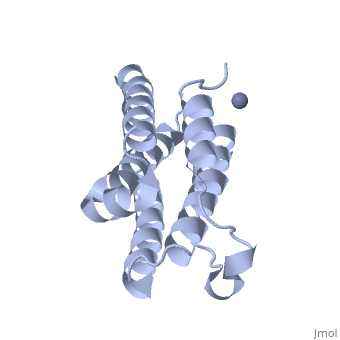Function
IFNα2b is a naturally secreted protein that is produced by the human body via antigen-presenting cells (APCs) [2]. When introduced to the body for treatment, IFNα2b is injected into the body subcutaneously and binds to the surface of cells [3]. When this occurs, IFNα2b produces many possible outcomes. This includes inhibiting replication of viruses within virus-infected cells, suppressing cell proliferation, enhancing activity of macrophages, stimulating certain types of enzymes, and increasing lymphocytes’ specific cytotoxicity [3]. Specifically in viral infections and malignancy, the interferon targets CD8+ effector T cells and CD4+ immunomodulatory T cells to amplify the body’s immune response [2]. It can also help induce a caspase cascade to activate cell death in virally infected and malignant cells [2]. Overall, INFα2b is crucial for activation and regulation of the protective immune response.
Structural highlights
Each IFNα2b monomer consists of five alpha helices and five coiled loops [4]. A zinc molecule is held within each IFNα2b monomer [4]. There are four significant cysteine residues on IFNα2b that create two disulfide bonds [1]. The first disulfide bond is between and [1]. The second disulfide bond is between Cys1 and [1]. IFNα2b is considered a Type I interferon and recognizes interferon alpha receptors 1 and 2 located on the target protein’s surface [1]. Amino acid residues on IFNα2b that participate in binding to IFNAR 1 and 2 are present on one coiled loop and four alpha helices [1]. These residues include: , , , , , , , , , , , , , , , , , , and [1].
Mechanism
There are several pathways in which IFNα2b has an effect on the target cell [1]. These pathways include the caspase cascade and the JAK-STAT pathway [1] [2]. The caspase cascade results in apoptosis, thereby participating in both anti-viral and anti-cancer mechanisms [2]. Once IFNα2b binds to either IFNAR 1 or 2 receptors, cytochrome c and tumor necrosis alpha factor trigger the caspase cascade, which in turn signals apoptosis [1]. In the binding of IFNα2b to an IFNAR receptor, the protein JAK (a tyrosine kinase) is activated [1]. JAK is phosphorylated and in turn phosphorylates the IFNAR receptors [1]. The IFNAR receptors bind to STAT proteins resulting in a cascade pathway that signals the release of antiviral proteins [1].
Disease
Hepatitis Virus
Hepatitis B
IFNα2b treats chronic Hepatitis B (HBV) by interfering with viral DNA synthesis and enhancing the cellular immune response [5]. The cytokine enhances T-cell and natural killer cell activity by interacting with the infected cell’s surface [5]. IFNα2b also activates antiviral enzymes to inhibit proliferation of HBV [5].
Hepatitis C
Hepatitis C (HCV) can range from acute to chronic conditions and progression occurs in more than half of these cases [6]. HCV attacks the liver tissues causing inflammation and cirrhosis, which can lead to chronic liver disease [6]. IFNα2b is used to treat the acute stage of HVC to prevent progression into the chronic disease [6]. IFNα2b overall reduces the viral amplification and allows T-cells to effectively respond to the infection [7].
Cancer
Multiple Myeloma
IFNα2b has been shown to prolong patients with multiple myeloma [8]. Multiple myeloma is diagnosed when multiple clones of a specific plasma cell are found or when apparent genetic mutations are affecting the cell’s normal functions [8]. IFNα2b therapy causes tumor stabilization and prolongation of the aggressive stage of multiple myeloma with maintained therapy [8].
Hairy cell Leukemia
IFNα2b is a major treatment for patients with hairy cell leukemia [1]. The disease is characterized by B cells in the blood, bone marrow, and spleen [1]. Patients who receive the therapeutic treatment experience partial to complete remission [1]. The treatment is especially effective because there is rarely relapse of the cancer with consistent therapy and mild side effects [1]. The presence of malignant cells decreases, predominantly in the bone marrow, and hematologic levels normalized [9]

